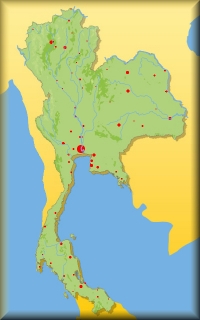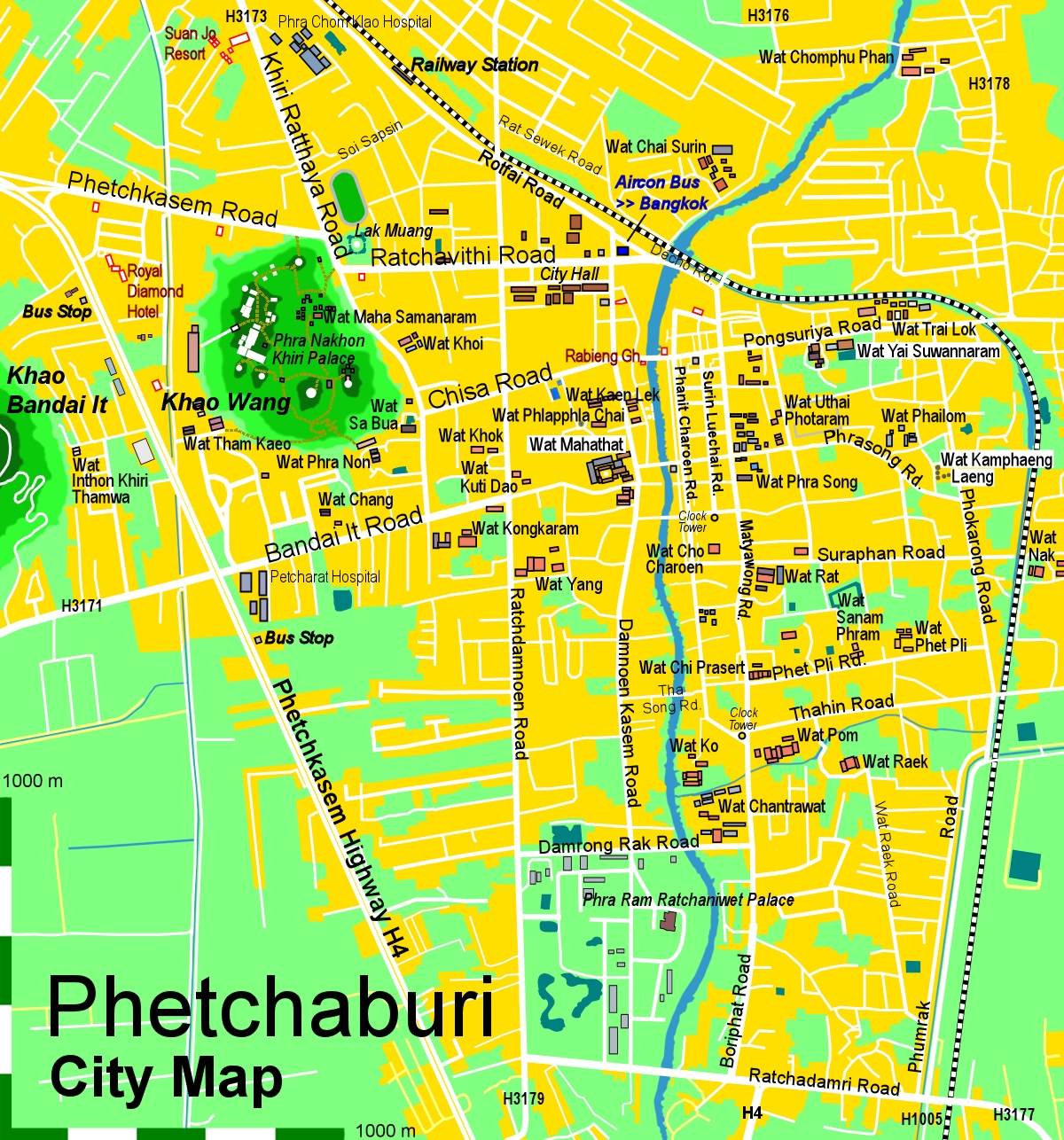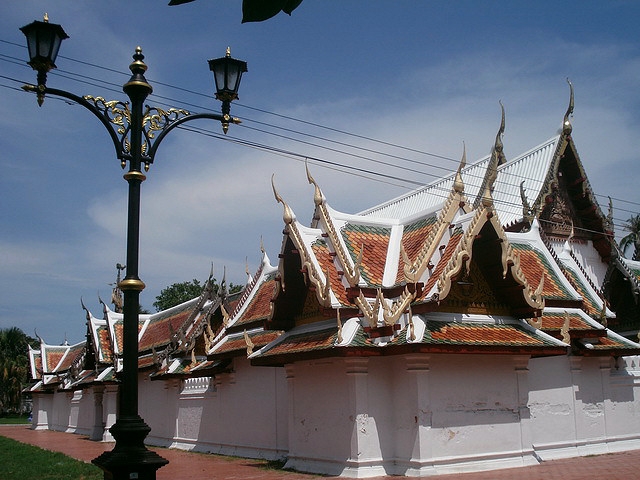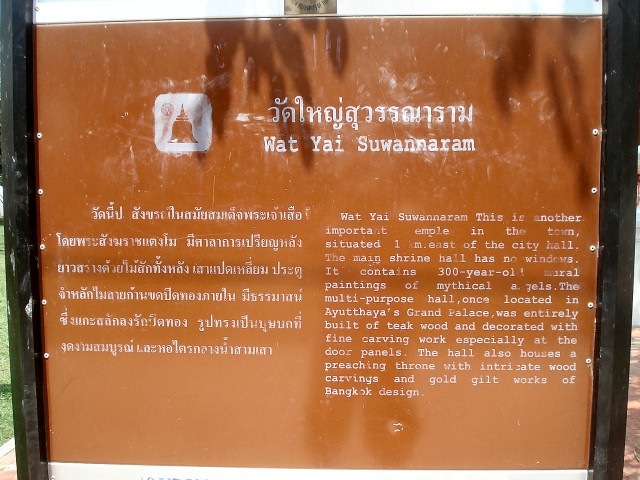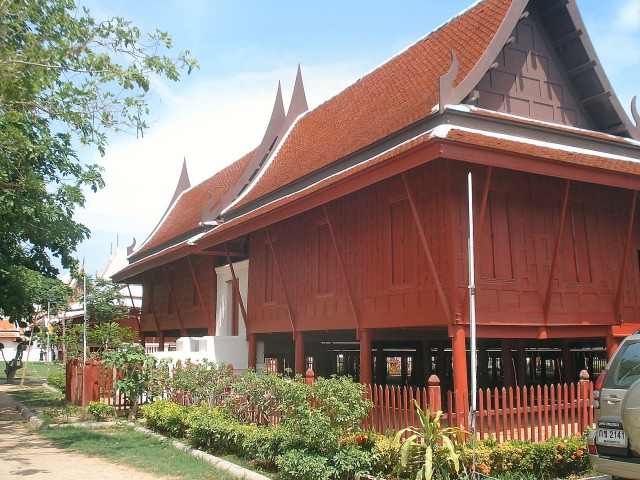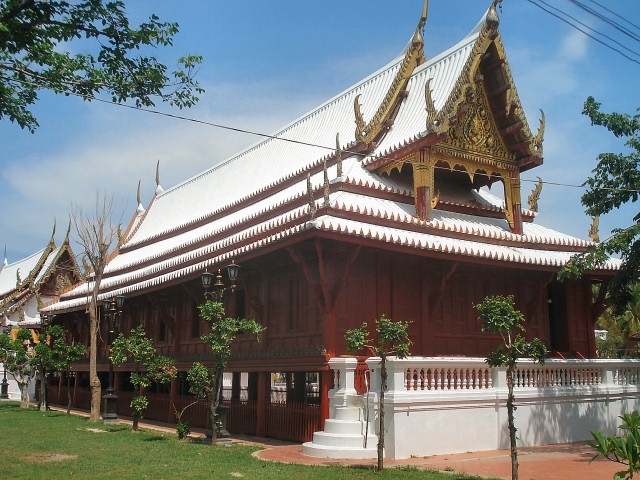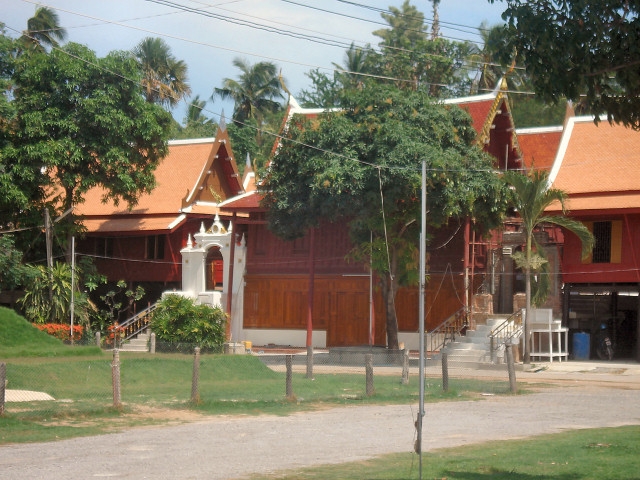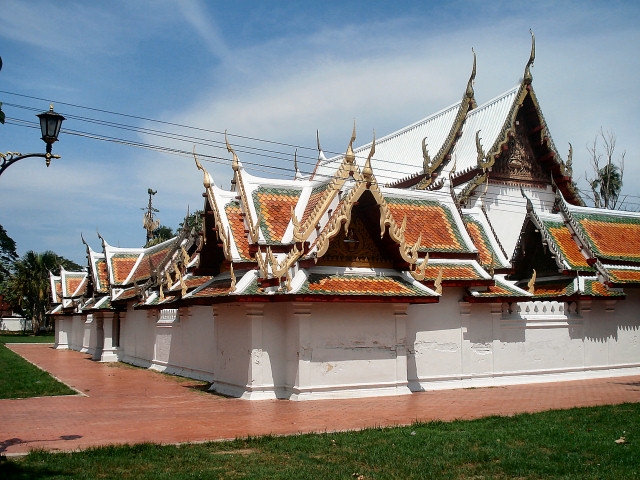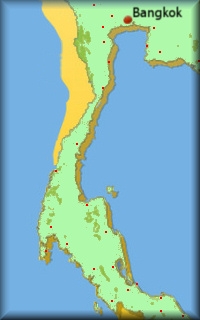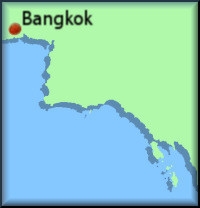 |
Phetchaburi
Destination: Phetchaburi
There are 31 temples in Phetchaburi town which can be explored in the city area alone. All these temples are displayed on our Phetchaburi map.
The most attractive temples in Phetchaburi are: Wat Mahathat to the west of the center with a very active religious life, Wat Yai Suwannaram in the center and the ruins of Wat Kamphaeng Laeng to the east of the center. These three temples are described here. For a temple tour to the 8 main temples please check out the special page Main Temples and for visiting the most interesting temples in Phetchaburi by bicycle please use our page More Temples. Temple >>
Wat Mahathat (Wat Mahathat) (Phetchaburi) 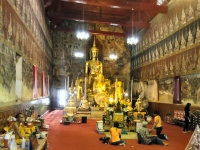 Wat Mahathat Worawihan (its full name) in the city center is more than 1,000 years old. In recent years Wat Mahathat was restored and enlarged. From the outside the prang with its five tall, corn-shaped stupas as well as the chedi with the four-headed Brahma gives an impressive sight. Wat Mahathat Worawihan (its full name) in the city center is more than 1,000 years old. In recent years Wat Mahathat was restored and enlarged. From the outside the prang with its five tall, corn-shaped stupas as well as the chedi with the four-headed Brahma gives an impressive sight.The main hall is painted with scenes from the Ramayana and is used by many people for praying and offering sacrifice. Almost every morning various groups perform temple dances in front of this building. A large monastery area and a school are adjoined to the temple. Temple >>
Wat Yai Suwannaram (Wat Yai Suwannaram) (Phetchaburi) 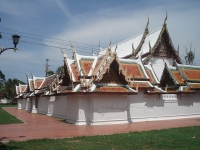 Wat Yai Suwannaram dates from the Ayutthaya period. It was renovated during the reign of King Sua or King Si Sanphet VII of Ayutthaya. It houses many beautiful wooden buildings. The central windowless bot's interior walls are decorated with over 300-year-old wall paintings showing among others, mythical creatures. You can ask to open the door. The Wiharn features particularly beautiful wooden entrance gates which are decorated with carved and gilded flower motifs. Wat Yai Suwannaram dates from the Ayutthaya period. It was renovated during the reign of King Sua or King Si Sanphet VII of Ayutthaya. It houses many beautiful wooden buildings. The central windowless bot's interior walls are decorated with over 300-year-old wall paintings showing among others, mythical creatures. You can ask to open the door. The Wiharn features particularly beautiful wooden entrance gates which are decorated with carved and gilded flower motifs.The legendary axe mark and the magnificent front door panels are the most beautiful and perfectly carved gilt work in this temple. It is believed that Burmese soldiers left an axe mark on the door panel. The Holy Sermon Hall was built in a classical style. There are some valuable religious artifacts and murals remaining on the wooden walls. The extraordinary three-pole library is built on three poles in a pond. It is used for keeping religious scripts out of the reach of insects. Wat Yai is located on Phong Suriya Road, about 1 km. from the City Hall.
Temple >>
Wat Kamphaeng Laeng (Wat Kamphaeng Laeng) (Phetchaburi) 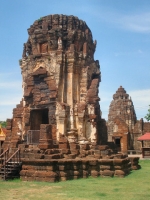 This temple was formerly a Khmer sanctuary in Hinduism, but adapted into a Buddhist temple in the Mahayana Sect and Theravada Sect, respectively. Originally it comprised 5 laterite prang towers; only 4 of them remain at present. It is assumed that each tower was dedicated to and housed an image of a Hindu god; such as Shiva, Visnu, Brahma and Uma. This temple was formerly a Khmer sanctuary in Hinduism, but adapted into a Buddhist temple in the Mahayana Sect and Theravada Sect, respectively. Originally it comprised 5 laterite prang towers; only 4 of them remain at present. It is assumed that each tower was dedicated to and housed an image of a Hindu god; such as Shiva, Visnu, Brahma and Uma. This is based on the fact that an image of the Goddess Uma or Parvati was discovered in a tumbled tower in 1956. When it was adapted to become a Buddhist temple, an ordination hall was constructed. However, the original surroundings were slightly changed as evident from the remaining laterite wall. The five prangs in Wat Kamphaeng Laeng were constructed during the Khmer rule from 1157– 1207. Each of the four preserved towers houses a Brahman deity, presumably Indra, Narain, Brahma as well as Uma, whose statue has been found in the destroyed prang. The old complex made of sandstone has been converted into a Buddhist temple. It is located on Phra Song Road, some 2 kms. from the City Hall. Museum >>
Phra Ram Ratcha Niwet Palace (Phra Ram Ratcha Niwet Palace) (Phetchaburi) 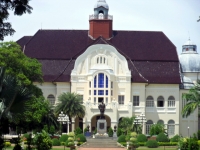 Ban Puen Palace was constructed from 1909 to 1916 by a German architect in European style. It served as a residence for King Rama V during the rainy season. Ban Puen Palace was constructed from 1909 to 1916 by a German architect in European style. It served as a residence for King Rama V during the rainy season. The magnificent Baroque-style Palace of King Chulalongkorn, Rama V, is known as Ban Puen Palace. King Rama V had it constructed for his retreat in rainy seasons. The palace has adopted the modern European architecture designed by the German architect Karl Dohring with his countryman, Dr. Bayer, as the engineer. The palace was named Phra Ram Ratcha Niwet in 1918 to serve as a reception hall for state visitors. Later, King Rama VII turned it into the location of the Boy Scouts Commanding School, Agricultural Teachers Training School, and Sub district Elementary School. Phra Ram Ratcha Niwet is located in the south of Phetchaburi city.
|
New to t-Globe?
Register for free to get the full power of this web site!
Registered members will be able to: |
||||||||||||||||||||||||||||||||||||||||||||||||||
|
|

